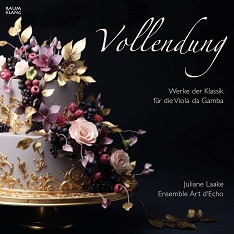Wieder einmal hat ein Virtuose Kompositionen für sein Instrument mindestens beeinflusst, hier sogar teilweise selber komponiert oder bearbeitet hat. Gemeint ist Franz Xaver Hammer, der ab 1785 als Gamben- und Cellovirtuose am Hof von Mecklenburg-Schwerin im Barockschloss von Ludwigslust agierte. Sein überliefertes Notenarchiv zeigt eine Reihe von Werken, die erst in der Klassik entstanden, einer Zeit also, so wurde das bisher meist gesehen, als die Gambe als Instrument des Barocks schon verschwunden war.
Die Gambistin Juliane Laake hat die Sammlung betreut und für die Einspielung aus diesen Werken ausgewählt. Zusammen mit dem Ensemble Art d’Echo kann sie musikalisch darlegen, dass die Viola da Gamba sich durchaus auch in der Klassik hören lassen kann. Und das betrifft sowohl das zu der Zeit verwendete Instrumentarium wie auch die Stilistik. Dass die Musiker dabei ihre aus der Interpretation früherer Epochen, also vor allem des Barock, gewonnenen Ideen von fantasievollem musikalischem Ausdruck und technisch reifem Spiel auch auf diese Epoche übertragen haben, ist nicht überraschend. Sie erweitern es um galante Momente und neue Spielweisen der Klassik, so dass ihnen eine Bereicherung des Repertoires gelingt.
Once again, a virtuoso has at least influenced compositions for his instrument, and in this case even composed or arranged some of them himself. We are talking about Franz Xaver Hammer, who worked as a viola da gamba and cello virtuoso at the court of Mecklenburg-Schwerin in the baroque palace of Ludwigslust from 1785. His surviving music archive contains a number of works that were not composed until the Classical period, a time when the viola da gamba had already disappeared as a Baroque instrument.
The viola da gamba player Juliane Laake has supervised the collection and selected works from it for the recording. Together with the Ensemble Art d’Echo, she can musically demonstrate that the viola da gamba can also be heard in classical music. And this applies to both the instruments used at the time and the style. It is not surprising that the musicians have transferred the ideas of imaginative musical expression and technically mature playing they gained from the interpretation of earlier eras, especially the Baroque, to this era. They expand it with gallant moments and new playing styles from the classical period, so that they succeed in enriching the repertoire.


















